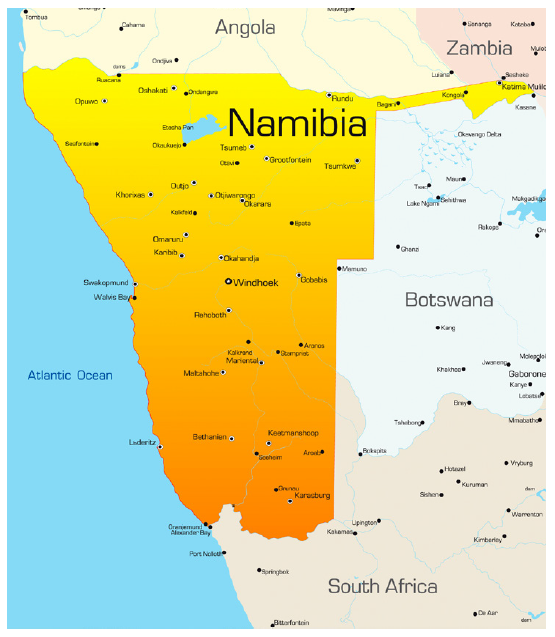Borrower Overview
TriLinc has provided financing to a consumer goods importer and distributor located in Namibia. Incorporated in 2006, the borrower distributes imported proprietary brand products to small, medium, and largescale retailers throughout Namibia and other markets in Sub-Saharan Africa. The borrower’s product lines, which include sugar, rice, washing powder, UHT milk, and canned sardines, are sourced from international suppliers in Brazil and India, among others. It is anticipated that TriLinc’s financing will enable the borrower to increase its number of distribution channels, expand its regional footprint, and continue to grow its employee base in a country historically noted for its high unemployment rate. The transaction is part of a purchase and repurchase trade finance facility that is secured by inventory as well as receivables.
Market Overview

Namibia is classified as an upper middle income country by the World Bank1. Between 2010 and 2013, GDP growth rates averaged approximately 5.9%2. Major exports include diamonds, copper, gold, zinc, lead, uranium, cattle, white fish, and mollusks3.
Namibia meets TriLinc’s country standards for its performance across relevant growth, stability and access metrics4. In 2013, it ranked 98th in the world and eighth across the region on the World Bank’s Ease of Doing Business index5. With a GDP of $12.58 billion6,the country has greatly benefited from a close economic relationship with South Africa as well as an estimated $32 billion in foreign direct investment that flowed to the region in 20137. Robust domestic demand across Sub-Saharan Africa has helped spur real GDP growth of up to 4.7% in 2013, and is expected to remain stable at 4.7% in 20147. Looking ahead in 2015 and 2016, overall regional GDP growth is projected to strengthen to 5.1%7.
Additional Sustainability & Impact Highlights
- The borrower targets job creation as the primary impact objective of its business activities.
- The borrower seeks to promote equality and empowerment in Namibia by targeting Namibia’s minority and/or previously excluded communities in its hiring efforts.
- The borrower strengthens food security in Sub-Saharan Africa by providing affordable and accessible consumer staple products to both Namibian and regional markets.
1World Bank, Doing Business 2014, Economy Profile: Namibia. 2World Bank, World Development Indicators Database, 2014. 3CIA, The World Factbook, 2014: Namibia. 4There is no assurance that our investment in this company or this market will be successful. 5The World Bank, Doing Business 2014, Understanding Regulations for Small and Medium-Size Enterprises. 6World Bank: GDP Ranking; 2014. 7The World Bank, Global Economic Prospects, 2014
The above information is as of the initial date of investment: July 25, 2014.
This borrower is no longer a TriLinc fund investment.
TriLinc originally performed an SDG mapping exercise in December 2017 to map all of our borrower companies, both current and exited from our portfolios, to specific SDGs based off of business activity. TriLinc’s official SDG alignment methodology was not finalized until June 30, 2018. For borrowers that had exited TriLinc’s portfolios prior to this time period, the selected SDGs for these borrower are a reflection of what TriLinc believes would have been the SDG alignment if 1) the SDGs had been in effect and 2) TriLinc had integrated the SDG alignment while the company was in the portfolio. The SDG mapping presented does not include input from Investment Partners or borrower companies given that the companies were no longer in the portfolio when the alignment was finalized.
An investment with TriLinc carries significant fees and charges that will have an impact on investment returns. Information regarding the terms of the investment is available by contacting TriLinc. This is a speculative security and, as such, involves a high degree of risk. Investments are not bank guaranteed, not FDIC insured and may lose value or total value. Some investments may have been made in an investment vehicle that is no longer open for investment. The highlighted investment may or may not have been profitable. There is no guarantee that future investments will be similar.
Want to learn more? Contact Us.
